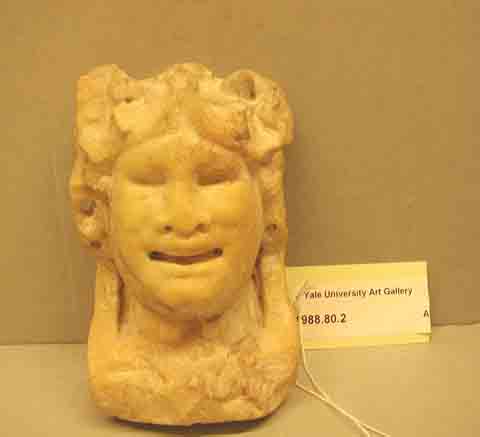
The latest exhibit at the Yale University Art Gallery called Pompeii: Photographs and Fragments shows not only the ancient 1st-century site, but also its rediscovery in the 18th century. The city famously was buried by the volcanic eruption of Mount Vesuvius. But the nature of lava preserved many bodies, and many fragments of civilization and buildings survived.
The exhibit is composed of photographs by William Wiley of many somewhat-intact sites, a photo book by An-My Lê, as well as small fragments from the site. The two photographers both created their work while they were artists in residence under the Happy and Bob Doran program in Praiano, Italy, in the last decade.
One photograph by Wylie is of a wall of one of the buildings. The wall is painted with images of houses, people and trees. But the wall is cut with cracks and missing chunks. This grants the appearance of several dimensions, one created by an artist’s hand, one created by history. The world of art bleeds into the real world.
Another particularly haunting image is of a plaster cast of a body, that looks like a deceased person killed in the disaster. The picture makes it appear as if some enterprising photographer rushed in just after the disaster and captured the horror of the event. But in fact the figure is just a very accurate replica. The volcanic ash from the eruption fossilized the dead bodies of the residents of Pompeii, and when the bodies decomposed, they left voids shaped like the dead Pompeiians. When archaeologists found them, they poured plaster in, creating casts that were replicas of the dead. Nonetheless, the photograph gives the viewer the sense of the drama and terror of the eruption, transporting the viewer back in time.
One striking picture shows a small group in Victorian dress sitting on some lava rocks. When archaeologists found the site again in the 18th century, it captured the public’s attention. When presented to viewers, the exhibit becomes not only about the site, but also about people’s reactions to it. It implicitly tells us that what is important in museums is not only the art itself, but also what we, the audience, thinks about it. Indeed, many artists, such as Rothko, who has a piece in the same museum, create their work with the intention of evoking an emotional reaction in the viewer, thus flipping the power dynamic of the famous artist and the nameless viewer.
The breadth and high quality of Wylie’s photos make the viewer feel as if she is there, walking the grounds of this ancient city. We are taken into homes, an amphitheater, and temples. We see much of the experience of the ancient resident of this city. The pictures also give a beautiful peek into the ancient architecture and art. In one image we see a herm, a column with a bust, usually of Hermes, at the top. These columns typically also included a piece of male gentialia in the middle of the column, but people thought those additions were indecent and cut them off, so few exist today.
The objects from Pompeii itself offer a small glimpse into what life was like there. One case includes several small vessels used for drink or decoration. One piece is an example of Arretine ware, red-slipped tableware used in the home. Pieces found at Pompeii are some of the earliest and best examples of this type of pottery. There are also three fragments of mosaic from Herculaneum, a nearby town that faced the same effects from the volcano as Pompeii. The mosaic fragments are a gorgeous glimpse into the Greco-Roman style employed at the time. One depicts the corner of a Classical building, complete with columns and a pendentive.
The other photographer, An-My Lê, focused on a very different aspect of Pompeiian life. She created a photobook with images of the Bay of Naples on one side, and erotic art from Pompeii on the other. Many of the artifacts uncovered at Pompeii were of a sexual nature, including frescoes and household items adorned with fertility or sexual imagery. In the spirit of representing not just the ancient objects, but viewers’ reaction, the book perhaps pokes fun at the prudish nature of the 19th-century people who saw these images. The public at the time was so aghast with this ancient pornography that many of these artworks were put in a special restricted area within the Museo Archeologico Nazionale di Napoli, in a room called the Secret Cabinet.
Today, these artifacts are left on view to the public until Aug. 19 unrestricted, and ready for viewers’ reactions.
Claire Kalikman | claire.kalikman@yale.edu .







